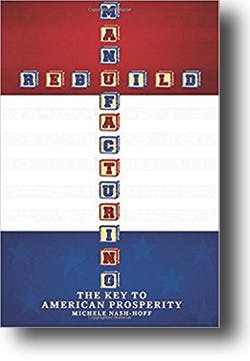In her latest book chronicling the state of U.S. manufacturing and the policy changes needed to shore up the sector, Michele Nash-Hoff, a contributor to IndustryWeek, notes that one of her ancestors was Paul Revere. While Nash-Hoff has not been galloping through the Massachusetts countryside warning of British troops, she has been crisscrossing the United States in recent years visiting American factories, warning of threats to domestic manufacturing and offering advice on how to rebuild the manufacturing ecosystem. Paul Revere, a celebrated silversmith who also ran a foundry after the Revolutionary War, would be proud.
Rebuild Manufacturing (Coalition for a Prosperous America, 2017) starts off with a recounting of statistics that are familiar to many manufacturers but still shocking. The U.S. lost 5.86 million manufacturing jobs between 2000 and early 2010, or roughly the populations of Chicago, Houston and Indianapolis combined. During that decade, the U.S. lost 57,000 manufacturing firms.
Throughout this period and for a considerable time before, educators and parents were watching (or experiencing) what was happening in manufacturing. The lesson they imparted to countless kids: Manufacturing has no future in the U.S. and neither will you if you choose a career in a factory.
Thanks to a long recovery beginning in the Obama administration and continuing in the Trump presidency, manufacturing is coming back, though that journey is far from over. Activists such as Nash-Hoff have helped turn the tide against the popular belief in Washington and other centers of economic thought that the U.S. had grown out of the need for manufacturing. It is increasingly clear that a vibrant manufacturing sector is crucial to a healthy and growing U.S. economy.
In Rebuild Manufacturing, Nash-Hoff offers a wealth of information and recommendations on what can be done to strengthen U.S. manufacturing. She points the finger repeatedly at the huge trade imbalance with a mercantilist China (in 2017, nearly $309 billion through October) and calls for action by Trump and Congress to fight intellectual property theft and take a much tougher stand against acquisitions of American companies by Chinese firms.
"Letting Chinese corporations acquire American companies, especially energy or technology-based companies is the biggest threat to rebuilding American manufacturing," Nash-Hoff writes. "We must not allow this policy to continue if we want to maintain our national sovereignty."
Nash-Hoff is clearly in favor of current efforts by the Trump administration to redraw NAFTA so that trade with Canada and Mexico is more balanced. Through October 2017, the U.S. deficit with the two NAFTA partners was $74 billion.
None of America's current trade agreements, Nash-Hoff notes, deal adequately with threats such as currency manipulation, value-added taxes (VATs), government subsidies for state-owned enterprises and product dumping to take market share by offering goods below their cost to produce.
America needs a "national strategy" that addresses trade, writes Nash-Hoff, so that it benefits Americans broadly, not just "American corporations that expanded their global sales or moved manufacturing to other countries to increase their profits."
Reshoring is a key to reinvigorating U.S. manufacturing, Nash-Hoff asserts. She says if company leaders used Total Cost of Ownership (TCO), as advocated by the Reshoring Initiative, to fully assess the costs of foreign versus domestic production, they would bring back manufacturing to the U.S. in a volume that would add millions of jobs and greatly reduce the trade deficit.
Investment in advanced technologies such as additive manufacturing and robotics could "spell a bright future for American manufacturing," the author states, by lowering production costs and improving quality. She also addresses the need for U.S. manufacturers to implement lean broadly in their companies, not just on the factory floor.
Rebuild Manufacturing: The Key to American Prosperity is worth careful consideration, whether you agree with all its prescriptions for strengthening America's manufacturing competitiveness or not. Maybe you'll come away ready to light a lantern or two to alert our political leaders to the threats facing U.S. manufacturing in the 21st century.





